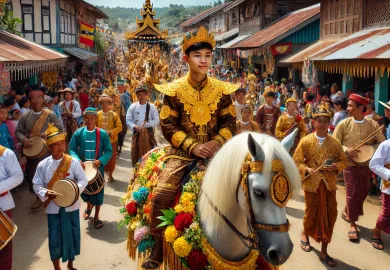
The Carnevale di Ivrea is one of Italy’s most distinctive and exuberant festivals, rooted in history and tradition. Each year, the small town of Ivrea in the Piedmont region comes alive with color, energy, and the exhilarating “Battle of the Oranges.” This festival is not just about celebration; it’s a symbolic re-enactment of a medieval struggle for freedom. Let’s dive into the rich history, unique traditions, and vibrant atmosphere of the Carnevale di Ivrea.
The Historical Origins of Carnevale di Ivrea
The Carnevale di Ivrea traces its origins back to medieval times, when the citizens of Ivrea rebelled against their oppressive rulers. The most famous legend surrounding the carnival involves Violetta, a miller’s daughter who refused the advances of a tyrannical local lord. In an act of defiance, she struck him down, sparking a popular uprising that led to the town’s liberation. This historic event is symbolically re-enacted during the carnival each year, particularly in the form of the Battle of the Oranges.
This carnival has evolved from a local tradition into a major cultural event, drawing visitors from all over Italy and beyond. The event’s deep connection to Ivrea’s history gives it a unique character that sets it apart from other carnivals in Italy. It is not just a celebration but a reminder of the town’s spirit of resistance and independence.
The festival has been celebrated for centuries, but it became particularly well-organized in its modern form during the 19th century. Since then, the people of Ivrea have continued to celebrate their history and culture with the same fervor and dedication, making Carnevale di Ivrea a must-see event for anyone interested in Italian history and tradition.
The Iconic Battle of the Oranges
The Battle of the Oranges is the centerpiece of the Carnevale di Ivrea, a chaotic and colorful spectacle that takes place over three days. Participants, divided into nine combat teams, hurl oranges at each other in a symbolic re-enactment of the medieval struggle. The oranges represent the weapons used in the fight against the oppressive rulers, and the battle is a way for the people of Ivrea to remember and celebrate their ancestors’ fight for freedom.
The battle is not for the faint-hearted, as participants fiercely throw oranges with a mixture of excitement and determination. The streets of Ivrea are transformed into a battlefield, with orange pulp and juice splattering everywhere. Despite the intensity of the battle, there is a strong sense of camaraderie among participants, as they unite in this shared tradition.
The tradition of using oranges in the battle is believed to have started in the 19th century. Initially, beans were used, but over time, oranges became the chosen fruit, possibly due to their symbolic value and the fact that they are plentiful in the region during carnival season. Today, the Battle of the Oranges is a symbol of Ivrea’s enduring spirit and a highlight of the carnival.
The Role of the Mugnaia and Other Key Figures
At the heart of the Carnevale di Ivrea is the figure of the Mugnaia, or the Miller’s Daughter, who plays a central role in the festivities. The Mugnaia is a symbol of the people’s defiance and is honored as the heroine of the carnival. Each year, a local woman is chosen to play the role of Violetta, and she leads the celebrations, dressed in a white gown and a red cap, symbolizing purity and rebellion.
The Mugnaia’s appearance is one of the most anticipated moments of the carnival. She is paraded through the streets of Ivrea in a grand procession, accompanied by the General and other key figures, including the Scarlo, the carnival’s “king,” and the Abbà, representing the city’s various districts. These figures, dressed in elaborate historical costumes, add to the pageantry and grandeur of the event.
The General, another important figure, is responsible for maintaining order during the carnival and leading the parades. The General’s entourage, known as the Staff of Command, includes various officers who ensure the smooth running of the festivities. Together, these figures create a vivid tableau that brings the history and traditions of Ivrea to life.
The Festive Atmosphere and Local Traditions
Beyond the Battle of the Oranges and the symbolic figures, the Carnevale di Ivrea is filled with various local traditions that contribute to its festive atmosphere. The town is decorated with colorful banners and flags, and the streets are filled with the sounds of marching bands and cheering crowds. The vibrant energy of the carnival is infectious, drawing visitors into the celebrations.
One of the key local traditions is the preparation and distribution of the fagiolata, a traditional bean stew that is served to participants and spectators. This dish is a staple of the carnival and reflects the communal spirit of the event. The fagiolata is prepared in large quantities and distributed freely, ensuring that everyone is well-fed and ready to participate in the festivities.
In addition to the fagiolata, there are numerous other food stalls offering local specialties, such as salami, cheese, and wine. The carnival is a feast for the senses, with the sights, sounds, and tastes of Ivrea creating an unforgettable experience for all who attend.
The carnival also features various parades and performances, including the historical parade, where participants dressed in medieval costumes march through the streets, reenacting scenes from Ivrea’s past. These events add to the overall atmosphere of the carnival, creating a sense of continuity between the past and the present.
Planning Your Visit to Carnevale di Ivrea
If you’re planning to visit the Carnevale di Ivrea, there are a few things you should keep in mind to make the most of your experience. The carnival typically takes place in February, with the main events occurring over the three days leading up to Shrove Tuesday. It’s advisable to arrive early to secure accommodation, as the small town of Ivrea can get crowded during the carnival season.
To fully immerse yourself in the experience, consider joining one of the orange-throwing teams. While it may seem daunting, participating in the Battle of the Oranges is an exhilarating way to connect with the local culture and history. However, be prepared for the physical demands of the battle, as it can be intense and exhausting.
For those who prefer to watch the battle from the sidelines, there are designated areas where spectators can safely observe the action without getting caught in the crossfire. Wearing a red hat or scarf is recommended, as it signals that you are a non-combatant and wish to avoid being targeted by the orange-throwers.
After the festivities, take some time to explore the town of Ivrea and its surroundings. The town is rich in history and offers numerous attractions, including the medieval castle, the cathedral, and the old bridge over the Dora Baltea River. The surrounding countryside, with its rolling hills and vineyards, is also worth exploring, providing a peaceful contrast to the excitement of the carnival.
Conclusion: A Unique Italian Carnival Experience
The Carnevale di Ivrea is more than just a festival; it is a living tradition that brings history, culture, and community together in a vibrant and unforgettable celebration. Whether you’re participating in the Battle of the Oranges, joining in the parades, or simply soaking in the festive atmosphere, the carnival offers a unique experience that captures the spirit of Ivrea.
Visiting the Carnevale di Ivrea allows you to witness a centuries-old tradition that has been passed down through generations, reflecting the town’s resilience and pride. It’s an event that showcases the best of Italian culture, from the historical reenactments to the lively street parties and the delicious local cuisine.
If you’re looking for an authentic Italian carnival experience, the Carnevale di Ivrea should be at the top of your list. It’s a celebration that not only entertains but also educates, offering a glimpse into the history and heritage of one of Italy’s most unique towns.








